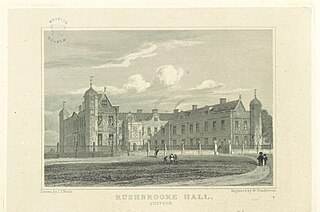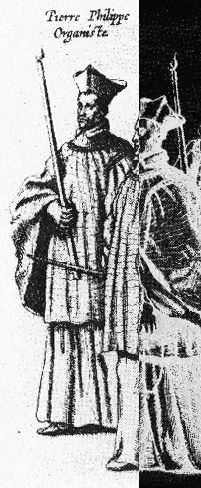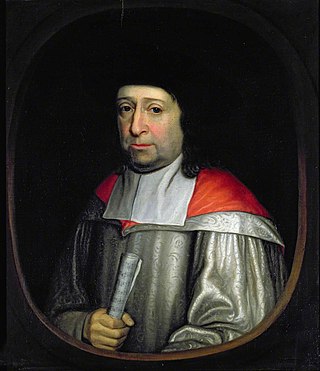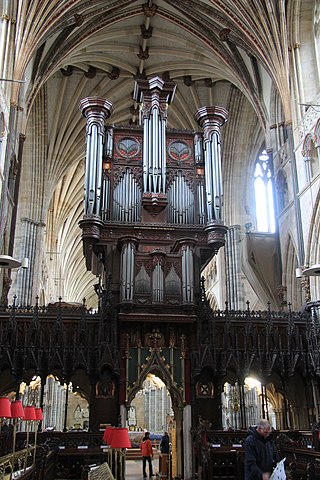
Thomas Tallis was an English composer of High Renaissance music. His compositions are primarily vocal, and he occupies a primary place in anthologies of English choral music. Tallis is considered one of England's greatest composers, and is honoured for his original voice in English musicianship.

Orlando Gibbons was an English composer and keyboard player who was one of the last masters of the English Virginalist School and English Madrigal School. The best known member of a musical family dynasty, by the 1610s he was the leading composer and organist in England, with a career cut short by his sudden death in 1625. As a result, Gibbons's oeuvre was not as large as that of his contemporaries, like the elder William Byrd, but he made considerable contributions to many genres of his time. He is often seen as a transitional figure from the Renaissance to the Baroque periods.

John Farmer was an important composer of the English Madrigal School. He was born in England during the Elizabethan period, and was also known by his skillful settings for four voices of the old church psalm tunes. His exact date of birth is not known – a 1926 article by Grattan Flood posits a date around 1564 to 1565 based on matriculation records. Farmer was under the patronage of the Earl of Oxford and dedicated his collection of canons and his late madrigal volume to his patron.
The English Madrigal School was the intense flowering of the musical madrigal in England, mostly from 1588 to 1627, along with the composers who produced them. The English madrigals were a cappella, predominantly light in style, and generally began as either copies or direct translations of Italian models. Most were for three to six voices.

Thomas Morley was an English composer, theorist, singer and organist of the Renaissance. He was one of the foremost members of the English Madrigal School. Referring to the strong Italian influence on the English madrigal, The New Grove Dictionary of Music and Musicians states that Morley was "chiefly responsible for grafting the Italian shoot on to the native stock and initiating the curiously brief but brilliant flowering of the madrigal that constitutes one of the most colourful episodes in the history of English music."
Thomas Tomkins was a Welsh-born composer of the late Tudor and early Stuart period. In addition to being one of the prominent members of the English Madrigal School, he was a skilled composer of keyboard and consort music, and the last member of the English virginalist school.

George Kirbye was an English composer of the late Tudor period and early Jacobean era. He was one of the members of the English Madrigal School, but also composed sacred music.

During the reign of Queen Elizabeth I (1558–1603), English art and high culture reached a pinnacle known as the height of the English Renaissance. Elizabethan music experienced a shift in popularity from sacred to secular music and the rise of instrumental music. Professional musicians were employed by the Church of England, the nobility, and the rising middle-class.

Peter Philips was an eminent English composer, organist, and Catholic priest exiled to Flanders in the Spanish Netherlands. He was one of the greatest keyboard virtuosos of his time, and transcribed or arranged several Italian motets and madrigals by such composers as Lassus, Palestrina, and Giulio Caccini for his instruments. Some of his keyboard works are found in the Fitzwilliam Virginal Book. Philips also wrote many sacred choral works.
John Bennet was a composer of the English Madrigal School. Little is known for certain of Bennet's life, but his first collection of madrigals was published in 1599.

"The Silver Swan" is a madrigal by Orlando Gibbons (1583–1625) composed during the early Baroque period. Gibbons's best-known song and among the most admired English madrigals, it is scored for five voices—cantus, quintus, alto, tenor and bass. The piece opens his First Set of Madrigals and Motets of 5 parts, published in London by Thomas Snodham in 1612 with support from the composer's patron Christopher Hatton.
John Mundy was an English composer, virginalist and organist of the Renaissance period.

Christopher Gibbons was an English composer and organist of the Baroque period. He was the second son, and first surviving child of the composer Orlando Gibbons.
Ellis Gibbons was an English composer of the late Renaissance who was associated with the English Madrigal School. Born in Cambridge to a musical family, Gibbons was the second surviving son of William Gibbons, a town wait. By 1598 he was known to be living in Cambridge's High ward, and later the Market ward. He owned property in Cambridge and London and probably spent much time there, presumably as a musician of some kind. At the age of 28 he became one of only two composers to contribute two pieces to The Triumphs of Oriana, a collection of 25 madrigals published in 1601. These madrigals were Long live faire Oriana and Round about her Charret; modern commentators generally favor the latter. No other compositions by Gibbons survive, and some scholars have doubted his authorship of these works, ascribing them to his brothers. Two months after his mother's death, his career was cut short by his early death in May 1603, leaving behind his brothers Edward, Ferdinando and Orlando, who would become the most famous musician of the family. Orlando's son, Christopher, was also a noted composer.
Thomas East was an English printer who specialised in music. He has been described as a publisher, but that claim is debatable. He nevertheless made an important contribution to musical life in England. He printed the significant madrigal collection, Musica Transalpina, which appeared in 1588.
Edward Johnson was an English composer. Johnson's compositions were highly regarded in his time, but few of them survive.
Il Trionfo Di Dori is a collection of 29 Italian madrigals published by Angelo Gardano in Venice in 1592. An edition and commentary was published by Edward Harrison Powley in 1974. In England the collection was imitated in The Triumphs of Oriana. In German the collection was edited as Musicalische Streitkrantzelein.

Osbert Parsley was an English Renaissance composer and chorister. Few details of his life are known, but he evidently married in 1558, and lived for a period in the parish of St Saviour's Church, Norwich. A boy chorister at Norwich Cathedral, Parsley worked there throughout his musical career. He was first mentioned as a lay clerk, was appointed a "singing man" in c. 1534, and was probably the cathedral's unofficial organist for half a century. His career spanned the reigns of Henry VIII and all three of his children. After the Reformation of 1534, the lives of English church musicians changed according to the official policy of each monarch.
Thomas Vautor was an English musician, known as a composer of madrigals.

Edward Gibbons was an English choirmaster and composer of the late Renaissance and early Baroque periods. Born in Cambridge, Gibbons's youth is completely unknown, but he later received degrees from the Universities of Cambridge and Oxford. From 1591/92 to 1598 he worked at King's College, Cambridge, as a lay clerk and choirmaster. During his tenure he married Jane, with whom he had six children. Gibbons's whereabouts the next few years remain uncertain; he may have lived in Acton, Bristol or Exeter, but by 1607 he was the choirmaster of the Exeter Cathedral, where the choristers included Matthew Locke. By 1609 Gibbons received a special dispensation to become a priest vicar, becoming the head of the college of priest-vicars and succentor. Jane died in 1628, and Edward married Mary Bluet; the family was evicted from their home during the English Civil War, but moved to their estate in Dunsford.











